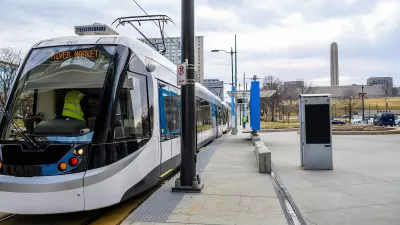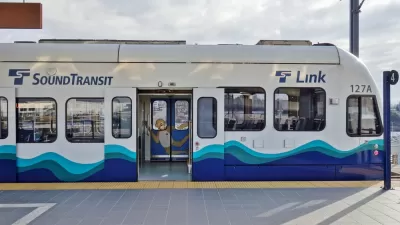I’ve confirmed that it is possible to take public transportation to the most suburban of suburban locations: the outlet mall.
I've confirmed that it is possible to take public transportation to the most suburban of suburban locations: the outlet mall. San Diego might not have the best public transportation system in the world, but it is an option here, which is a step ahead of many American cities. To get to the Carlsbad Outlets, I hopped on the San Diego Trolley, transferred to the Coaster commuter rail and then transferred again to a north county bus line. Presto! Almost two and a half hours later, I'm at the outlets (the trip typically takes 20 minutes by car, if traffic is light).
I also confirmed that I am the only person in San Diego County who would take public transit to an outlet mall on a Saturday afternoon; my bus both to and from the train station was completely empty. Now, I didn't mind the trip for a leisurely day of shopping because the drive on I-5 is a headache even without a traffic jam. But multiple transit connections would clearly be a deal breaker for anyone on a tight schedule, especially morning commuters.
Ridership is high only in cities that offer truly comprehensive transit systems – for example, subway stops in every neighborhood and trains that run often. Anyone who has traveled to European cities knows that rail-only trips are the most convenient. Add a rail-to-bus connection and things start to get a little tedious.
Because San Diego County's built environment is so sprawling and chaotic, the only possible way to reach many destinations is by car or, at best, a rail-to-bus trip with multiple connections. Should we expect any mass transit system to deliver riders to the middle of nowhere, let alone quickly and efficiently?
And that's exactly the problem. As long as we continue to build in the middle of nowhere, the car will be default mode of transportation. Take for example 4S Ranch, the pseudo New Urbanist complex located on virtual wilderness land in Rancho Bernardo, 25 miles northeast of San Diego. I guarantee that almost no one who lives in these new developments is working in Rancho Bernardo; most are commuting by freeway to San Diego. (There is currently no rail service to this area, nor should there be, considering the location and autocentric design of this suburb).
This does not mean that transit can't work well over large distances. In the early 1900's, electric rail flourished in Los Angeles and San Diego because the lines connected distinct satellite villages, with development concentrated around rail stops. LA's Pacific Electric successfully linked downtown, Hollywood, Burbank, Pasadena, Santa Monica and Long Beach – not exactly a compact area. San Diego's streetcars covered all of the main attractions, including Balboa Park, Ocean Beach, Pacific Beach and La Jolla – none of which are served by rail today.
While the City of San Diego was on the right track when it unveiled its "City of Villages" smart growth strategy in 2002, San Diego County continues to allow a suburban sprawl free-for-all. The county is now investing billions to relieve freeway congestion caused by the number of office parks, malls and poorly planned housing complexes that are randomly scattered across the landscape. Unless the two governments can work together to realize a sane growth strategy, it's hard to envision an effective county-wide transit system anytime soon.

Planetizen Federal Action Tracker
A weekly monitor of how Trump’s orders and actions are impacting planners and planning in America.

Chicago’s Ghost Rails
Just beneath the surface of the modern city lie the remnants of its expansive early 20th-century streetcar system.

San Antonio and Austin are Fusing Into one Massive Megaregion
The region spanning the two central Texas cities is growing fast, posing challenges for local infrastructure and water supplies.

Since Zion's Shuttles Went Electric “The Smog is Gone”
Visitors to Zion National Park can enjoy the canyon via the nation’s first fully electric park shuttle system.

Trump Distributing DOT Safety Funds at 1/10 Rate of Biden
Funds for Safe Streets and other transportation safety and equity programs are being held up by administrative reviews and conflicts with the Trump administration’s priorities.

German Cities Subsidize Taxis for Women Amid Wave of Violence
Free or low-cost taxi rides can help women navigate cities more safely, but critics say the programs don't address the root causes of violence against women.
Urban Design for Planners 1: Software Tools
This six-course series explores essential urban design concepts using open source software and equips planners with the tools they need to participate fully in the urban design process.
Planning for Universal Design
Learn the tools for implementing Universal Design in planning regulations.
planning NEXT
Appalachian Highlands Housing Partners
Mpact (founded as Rail~Volution)
City of Camden Redevelopment Agency
City of Astoria
City of Portland
City of Laramie





























